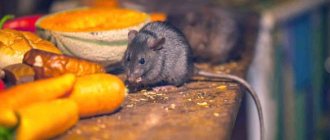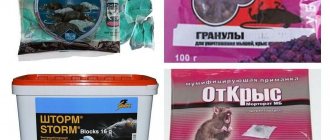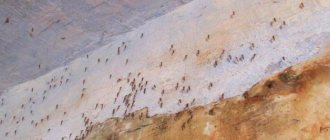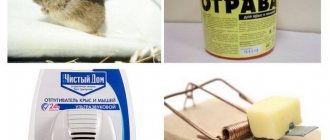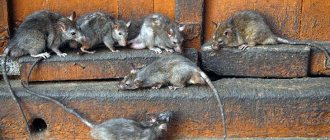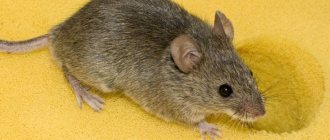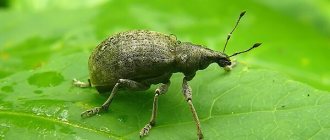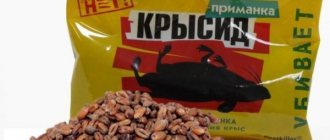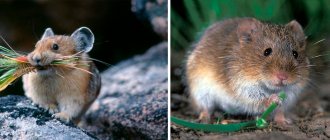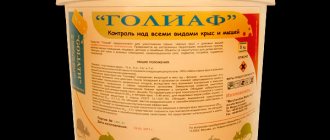The appearance of mice entails many troubles: damaged wiring, food, and the spread of infectious diseases. The goal of getting rid of them is to destroy them and take steps to prevent them from appearing again. There are chemicals for eliminating rodents - poisons, but they are not safe for humans. There are also folk ways of fighting: with the help of repellents, ash, etc. Mechanical or electronic traps, ultrasonic devices that you can buy or make yourself will help you get rid of the mouse brethren.
The appearance of rodents in the house - reasons and methods of recognition
The main reason why mice appear in the house is food. It is in search of food that they sneak into a person’s home. If cereals and other products are stored in bags in the household, then it is not difficult for rodents to get to them. The enemies of the crop in a summer cottage are field mice; they especially like seeds and nuts, and they eat them first.
The second factor that attracts parasites is heat. When the temperature outside drops, they move from cold basements closer to places that are heated. Rodents like unsanitary conditions and the presence of garbage. Therefore, people who neglect hygiene get them faster.
Mice can get into a home through water pipes, sewers, garbage chutes, and ventilation shafts. They enter the first floor from the basement. The following signs indicate their presence:
- obviously detected rodents;
- the presence of excrement in the form of black lumps near sources of water, food, and in secluded corners;
- unpleasant odor;
- chewed things, food, household items.
Mice cause significant damage:
- chew furniture and shoes, rendering them unusable;
- destroy food supplies;
- are carriers of various diseases;
- chewed wires can cause a short circuit or fire, which poses a danger to the lives of household members;
- The mouse smell is very unpleasant, all rooms and things are permeated with it, and it is difficult to get rid of it even after exterminating the rodents.
If there is even one sign of the presence of mice, you need to immediately take measures to eliminate them. Dealing with a large number will be much more difficult.
Signs of the appearance of mice in a private house, country house or apartment
- the appearance of oval-shaped excrement, about 2 mm in size;
- constant unpleasant smell of mice , which cannot be gotten rid of; it remains persistent even after general cleaning;
- the appearance of gnawed things, most often these are parts of furniture, baseboards, books, cardboard boxes;
- food products eaten by rodents: cheese, bread, nuts.
If signs of rodents are detected, you should immediately take the necessary measures to destroy them, since mice reproduce very quickly. About 10 rodents can be born in one litter, which after a couple of weeks will turn into adults and cause damage to the home or area. Colonies can number about 150-175 individuals.
Chemical control agents
The most effective method of getting rid of mice is poison, but it is also the most dangerous. The market offers a large selection of various pesticides against rodents. They are sold in the form of powders, suspensions, solutions, briquettes and gels.
The principle of action of the poison is the same: it causes internal bleeding or disruption of organ function, which leads to death. After the first dose, the drug may not be fatal, so it is necessary to create conditions for unlimited access to it. Lures have a cumulative effect. The results may take some time to appear. It is important to remember that the poison is dangerous, so its use should be done without the presence of animals and people.
The most popular chemicals are:
- Krysin. Brodifacoum is used as a base. The drug does not deteriorate from sunlight and is not afraid of moisture, so it is convenient for use in sewers, basements and other places with an aggressive environment.
- Brodifan. Rodents don't recognize it. Used as bait. After eating the product, mice begin to suffocate and die.
- Varat. The active ingredient is brodifacoum. Blocks blood clotting and causes suffocation. Rodents die completely two weeks after consuming poison distributed in their habitats.
- Testox. Available in tablet form. Lay out along the perimeter of the room in 3 m increments. Particular attention should be paid to places where the greatest mouse activity is observed.
- Rat death. It also contains brodifacoum. Causes pests to feel dangerous, which forces them to leave the home. This eliminates the need to dispose of dead animals. When dying, mice do not go far from their habitats. Therefore, after the etching procedure, every day you need to check all rooms for the presence of corpses and dispose of them immediately. As they decompose, they emit a very unpleasant odor.
It is better to use pesticides in summer cottages when people have left them for the winter.
How to deal with mice?
While in an apartment it is still possible to somehow wall up voids and leaks, in a private house it is almost impossible to do this - the ubiquitous rodents will always find somewhere to gnaw their way through. It has been noticed that passages usually appear in those places (I mean wood, not iron) where there is already a sufficient gap.
The mice expand it until they can't get through. For example, floor gaps under the baseboard, between the ends of the floor boards and the wall. Where the joints are tight and there are no cracks at all or can be well caulked and sealed, most likely mice will not chew anything. In short, these pests only expand existing cavities.
General Tips
- Firstly: I would not recommend using various homemade devices to kill mice with electric current, as some “knackers” advise, if you don’t want trouble. Electricity is dangerous not only for mice, but also for humans.
- Secondly: much less dangerous, painless and more humane means are available on sale.
- Thirdly: even if you poison all the mice in the house, this does not mean that they will disappear from your life forever. Sooner or later this problem will arise again, and nothing can be done about it. Life is a struggle.
It has been experimentally verified that mouse glue works quite effectively. True, mice do not always get into the glue themselves - most often they cleverly bypass this trick. Therefore, I spread glue on some cardboard cut from the packaging box and place it in a narrow passage - for example, between the refrigerator and the wall, depriving rodents of maneuver.
Important! Keep in mind that the glue gradually spreads after it is spread, so do not smear the very edges so as not to stain the floor or rug. The name of the glue does not matter; it is sold differently in different areas. I’m at the market from a seller selling mouse poisons, I’m just asking for mouse glue, I’m not interested in the name.
I haven’t bought grain poisons for a long time - they are apparently ineffective, or mice have developed immunity to them. Maybe I just came across something edible - I don’t know. Yes, and using them is inconvenient and troublesome.
Previously I bought poison in granules - the effect seems to be good - it works. But lately I have been buying poison in gray transparent bags containing small packets of green paste. If the expiration date has not expired, this is the most effective poison not only for mice, but also for rats.
In addition, the bags are convenient because you can throw them in places where your hand cannot reach - and “eat to your health.” It is necessary to take into account that poison for rodents is prepared in such a way that they do not die immediately, but after three to four days.
The fact is that the cunning “mouse gang” forces the most frail or sick relatives, and maybe even those unwanted, to try this poison first. And only when they see that their “subject” has gotten drunk and feels great at the same time, the others begin to eat.
If the poison acted instantly, then the losses among your “offenders” would be minimal. So don't bother chasing mice with a mop the next day because they won't die, no matter how much money you spend. Be patient. Victory will be yours.
Of course, mice can “throw their paws” in any inappropriate place, contrary to your wishes, sometimes you will not immediately detect them. And one day my daughter showed me a mouse sitting near her desk. The mouse sat with its eyes closed and did not move, in the pose of “too much.”
Attention! I think that they go outside in search of water to wash out their stomachs, but they were not fed for this purpose so that they could also give them something to drink... Well, of course, they cannot pour it for themselves. In such cases, I don’t hit or kick them in the head.
What am I, a beast or something? I take it with long metal tongs and into the water, not into a mug, but into a garbage can. At the same time, I calm my conscience: they say, there is no need to steal and violate the inviolability of my home.
I also read that rodents do not like ash - irritation appears on their paws from the ash, and it probably hurts. If only they could wipe their paws on something else... Otherwise, they will drag the ashes all over the house.
In the underground you can put a jar of plaster mixed with half and half flour, and a separate jar of water. After having lunch, the rodents will want to drink, and then a surprise awaits them, you know what it is. In such a situation, even laxatives will not help.
The mouse will not turn into a figurine, but you can get a plaster print of its stomach. I read that the smell of chamomile also repels mice, but I haven’t tried it - I don’t want to greet those nasty flowers. They don't like the smell of burnt rubber either.
It is not necessary to accelerate at home in a car and brake sharply. You can take pieces of rubber, light it, smoke it and then spread the smoked rubber in different places. Don't forget to put it out. I mean fire, otherwise someone will start asking for the recipe.
I think this is enough for the first time. I don’t want to promote more sophisticated and barbaric methods, such as setting the tail on fire, watching a mouse at a mousetrap and killing it by hand, or chasing mice around the house with a sharp pike.
Traditional methods of getting rid of rodents
Mice have highly developed hearing and sense of smell, so they will leave if unfavorable conditions are created for them in the form of unpleasant odors and sounds. Repellents emit a strong stench, which repels rodents, causing them mental disturbances and nervousness.
Repellents
Plants are natural repellents and are a safe and humane method of controlling mice. The main principle of action is the repellent aroma.
- Wormwood helps get rid of pests by fumigating the room. The operation will have to be performed several times to achieve the desired effect. During the procedure, you must wear a mask to protect against the foul odor.
- Hazel grouse bulbs emit an unpleasant onion smell, which rodents do not like, and they leave the habitat.
- Peppermint. People find its scent pleasant, but mice do not like it. Fresh branches of the plant are laid out along the walls and corners of the rooms, paying attention to places where animals may be found. After a few days they leave.
- Blackroot. The plant contains alkaloids that make mice feel dangerous. Even without contact with grass, rodents go crazy.
- Elderberry roots produce hydrocyanic acid, which is poisonous to mice. Elderberry can be planted to repel near a private house, and pests will not approach it.
- Swamp wild rosemary contains poisonous essential oil. The smell spreads over a long distance and negatively affects them. It is enough to place twigs around the perimeter of the house, the mice will leave it forever.
Rodents cannot tolerate the smell of tansy, chamomile, and pyrethrum. A decoction is prepared from them and sprayed on the home or laid out fresh grass in the habitats of mice.
Work with poisonous crops should be carried out wearing a mask and rubber gloves.
Alternative methods
Instead of plants that emit aroma, you can use essential oils. To repel pests, rags are moistened with scented oily substances, then laid out in secluded places and near the mouse nest. Do not forget that the concentrated product can also cause allergies in humans. The smells of seasonings are unpleasant for rodents: cilantro and coriander. Stocks will be saved if spices are placed in cabinets.
Mice will not enter the house if wood ash is scattered around. The alkali it contains has a negative effect on animals. When it gets on the paws, it corrodes them, rodents lick it off, resulting in irritation of the mouth and intestines. This method is useful in the countryside to fight vole mice.
Boric acid scattered on baseboards forces rodents to leave the home. This product should not be used in an apartment with pets and small children.
You can prepare a special sweet bait for mice, after eating which their gastrointestinal tract becomes clogged and they die. The recipe is simple: mix 300 g of flour, 200 g of sugar and 500 g of gypsum or quicklime. The mixture is scattered into small containers and placed in places where animals often appear.
Memo on deratization issues for the population
October 8, 2019
Memo on deratization issues for the population.
Initially, the term deratization (from the Latin rattus - rat and the negative prefix de) meant “destruction of rats”.
Currently, deratization is a whole system of preventive and extermination measures. It is impossible to completely exterminate rodents, you can only reduce their numbers.
Rodents are sources of pathogens of more than 70 infectious and parasitic diseases of humans and animals. This danger comes both from rodents living in close proximity to humans (rats, mice) and from wild ones (various types of voles, mice, steppe rodents, etc.).
The economic damage caused by rodents is great and varied: rodents destroy and spoil food and fodder, destroy seedlings of agricultural crops, damage buildings, hydraulic structures, gnaw and break the insulation of electrical and telephone cables and various electrical equipment.
Rodent control includes preventive and exterminatory measures. Preventive measures are aimed at depriving rodents of shelters and making it difficult for them to access food. How can this be achieved? In populated areas, this is achieved by improving the sanitary maintenance and sanitary-technical condition of territories and individual objects. When rodents have already appeared on the territory, it is necessary to carry out extermination measures. These activities consist of three main methods:
1) chemical,
2) physical,
3) biological.
-The chemical method is the main method of exterminating rodents; this method uses poisonous baits and gaseous substances.
-Physical method - the use of mechanical and physical tools to catch and destroy rodents.
-Biological method - the use of natural enemies of rodents (cats, dogs, birds) and various microbes that cause the death of rodents, but are safe for people and pets.
Preventive actions
They include sanitary measures, this is the cleaning of buildings, courtyards and other areas from garbage, which serves as either a source of food or shelter for rodents.
Maintaining order and cleanliness in food enterprises (grocery stores, bakeries, canteens, etc.), food warehouses, meat processing plants, slaughterhouses, and farms is especially important. It is important that food waste is inaccessible to rats and mice and kept in special containers. Garbage and waste from residential and industrial premises must be systematically removed. For example: about one container feeds 60 rats.
Disposal of waste and garbage is carried out by burning, composting, processing in biothermal chambers, where possible, as well as by constructing and maintaining landfills.
The purpose of sanitary measures is to block access of rodents to various buildings: residential buildings, food factories, warehouses, etc. Protection against rodents provides for the complete exclusion of the possibility of these animals entering certain places in the environment.
Such protection simply involves finding all openings in the premises that are larger than 6mm in diameter (the smallest opening a young mouse can fit through) and covering them with suitable rodent-proof material. Technical measures include covering doors with tin, sealing cracks, concreting and cementing floors, tiling walls, installing metal mesh in windows and other openings through which rodents can enter.
Sanitary and sanitary-technical measures in rural residential premises, in outbuildings in courtyard areas, and most importantly, in livestock buildings for livestock and poultry, as well as in premises for storing grain and other products, have the same goals and are achieved in the same ways, as for urban settlements.
Agrotechnical measures create unfavorable conditions for the existence and reproduction of rodents in open conditions. These measures lead to a reduction in the number of field rodents and, as a consequence, to the prevention of diseases transmitted through rodents.
These activities will include:
1) rational planning of land;
2) destruction of weeds on vacant lands, mandatory destruction of all thickets of weeds and dry grass;
H) timely and thorough harvesting and possibly quick plowing;
4) neatly stacking straw and hay and digging in stacks and stacks in grooves with steep walls;
5) protection of predatory animals (natural enemies of rodents) from aimless destruction.
Extermination activities.
Chemical method of control. The essence of the chemical method of deratization is the destruction of rodents with toxic substances. These substances act when they enter the intestines or lungs of rodents. The forms of use of deratization drugs are varied. These can be powders consisting of a single drug or a mixture of poison with various fillers (talc, starch, road dust, etc.), solutions and suspensions, fat-based pastes, waxed briquettes, biscuits, flour-crumb mixtures, etc. .
According to the nature of their origin, poisons are divided into plant and synthetic. Numerous drugs of synthetic origin are most widespread throughout the world. All synthetic poisons against rodents are combined into two large groups: drugs with acute and chronic action.
Acute poisons cause the death of rodents after eating the bait once. These include: arsenic compounds, zinc phosphide, scyliroside (red sea onion preparation), ratsid.
In most cases, these poisons begin to cause symptoms of poisoning from the very first hour after entering the body. However, with the rapid development of the poisoning process, rodents become wary and other surviving individuals refuse to eat the bait containing the poison that caused the poisoning. In order to overcome the reaction of avoiding poisoned bait, you should alternate the food base as well as poisons.
Poisons of chronic action are characterized by a long latent period, a slow development of the poisoning process with the regular introduction of very small doses into the body. These drugs accumulate in the animal’s body and gradually lead to significant changes in the body and death. The largest proportion of chronic poisons are poisons based on drugs that slow down blood clotting (zoocoumarin, diphenacin, etc.).
With a single ingestion of small amounts of these poisons into the rodent's body, symptoms of poisoning practically do not appear, but with repeated consumption, their toxicity increases significantly; as a result of the accumulation of poison in the body, the blood coagulation system is disrupted, which is accompanied by an increase in vascular permeability, hemorrhages in many internal organs and skin. and subsequent death of rodents.
The virtual absence of taste and unpleasant odor in poisoned bait with chronic poison does not cause wariness in rodents, they do not recognize it in the bait and the animals willingly and, which is very important, re-eat the poisoned bait in almost the same quantities as products without poison.
Currently, the following methods are widely used in deratization practice:
1) food poisoning baits - poison is mixed with a food product that is quite attractive to rodents;
2) liquid poisoned baits - the use of solutions or suspensions of poisons in water, milk and similar liquids;
Among all these methods, the most universal is the use of food poisoned baits. Poisoned baits can be conditionally divided (according to the moisture content in the food base) into dry and moistened, the latter being eaten much better, but spoiling faster. In all cases, it is best to eat only fresh, good-quality foods. Recently, ready-made baits in filter paper have appeared on the market for sale to the public, which do not quickly deteriorate in the air, but are happily eaten by mice.
The consumption of the food base of poisoned baits by rodents largely depends on the composition and abundance of food in their habitual living conditions.
What bait should I use? At facilities with a homogeneous food supply, the most preferred food base is one that compensates for the lack of individual components of their diet: at a meat processing plant, animals experience a clear deficiency of carbohydrates. The use of flour baits with sugar allows you to free these objects from them. In warehouses of grain, flour, and cereals, rodents eat high-calorie food containing most of the necessary components, but there is a lack of moisture, so liquid baits—milk, water with sugar—are the most effective. As a rule, adding food products that are attractive to rodents (for example, unrefined vegetable oil) to the food base significantly improves its palatability.
How to lay out baits? Baits are placed in burrows, bait boxes, or openly after their habitats have been identified. Poisoned baits are placed in inhabited or so-called “living holes,” that is, in those holes and crevices used by rodents. Baits with zoocoumarin that acts slowly and accumulates in the body must be laid out 3-4 days in a row or 2-3 times every other day.
Placing poisoned baits in bait boxes is as effective as the previous method. In addition, it is safe for others. Bait boxes must be clean, free of foreign odors, and should not be painted. The bait is placed at the bottom of the box. They place boxes near rodent exit points, along their paths, which most often run along walls, in quiet, secluded places. 2-3 days after laying out the bait, the boxes are checked; if it turns out that rodents are eating the bait, then the same bait is added.
In warehouses and production areas where there are few people and no pets, poisoned baits with zoocoumarin, ratindan and other anti-rodent poisons (rodenticides) that are of little danger to people and pets can be openly laid out. Poisons containing zoocoumarin should be carefully placed near pigs, as they are very sensitive to this poison.
Ready-made baits can be sold in different forms:
1. bait (cereals, granules, waxed blocks, briquettes, tablets, soft dough briquettes)
2. bait-free (pastes, foams and powders).
Substances that attract rodents are added to the bait.
Paraffin briquettes and pastes are one of the forms of serving poisoned food bait. The briquettes contain paraffin, vegetable oil, a toxic substance and a food base (grain or crumb crumbs). These are “Rat Death”, “Russian Trap”, “Storm”, “BoyKat”, “BoyKat-super”, 3D-racid”, etc. When purchasing ready-made or laboratory-prepared disinfectant grain, use it only to kill mice. For rats, use the baits listed above. Taking into account the taste preferences of rats, baits are available in various flavors: cheese, ham, chocolate, etc. To enhance the taste, you can add some food base to the finished bait, for example: vanillin. The rat likes the taste of beer. Both rats and mice love unrefined sunflower oil, so it is advisable to add it even to ready-made bait
Pastes are a sticky composition based on petroleum jelly, rodent poison (the correct name is rodenticide), vegetable oil and talc. The ratio of these components in the paste may vary. Pastes are used to create poisonous coatings (extermination platforms), poisoned baits, and coating the entrance holes of rodent burrows. Only baits belonging to hazard class 4, with various poisons, are offered for sale to the public.
Liquid poisoned baits.
Rats absorb large amounts of moisture, so water is used as bait, for example. In places where rodents do not find water, drinkers are placed with water pollinated with poisonous rodenticides. By absorbing poison-pollinated water, rats ingest rodenticide. Poisons used for pollination must not dissolve in water. Poisons soluble in water are not used in liquid baits, since rodents distinguish between poisonous solutions and usually do not drink them. Heavy drugs with this method of application are ineffective: rats carefully drink only the top layer of water and do not take the poison in the sediment.
Physical method of struggle. Among the various physical methods of exterminating rodents, the most common is the use of traps and traps, which can be divided into two main types:
1) live traps - traps, traps;
2) killing - dies and traps.
Traps and traps are used both indoors and in undeveloped areas. Catching rodents with arc traps is fundamentally different from catching with traps with bait in that it is based not on attracting animals, but on using the stereotype of their movements in the places they most frequently visit. This method of exterminating rodents is safe for people and pets. One of the positive aspects is that the results of using fishing gear (i.e., efficiency) are immediately revealed (unlike chemical and bacteriological agents). Thanks to its objectivity and clarity, it is used not only for the destruction of rodents, but also when examining objects in order to determine the presence of rodents and their type.
The use of traps is of little use for destroying a rodent population, but it is suitable for eliminating a small number of individuals that did not take the poisoned bait.
Numerous attempts to use ultrasonic devices to kill rodents (rats) have not yielded positive results. These devices are also of little use for scaring them away.
Mechanical means of extermination should also include the use of sticky masses to catch rodents. Typically, rosin and castor oil are used in a 2:1 ratio, lithographic varnish, thick molasses or other adhesive substances. To catch mice, the mixture is applied in a thin layer on thick paper or cardboard, and to catch rats, a 2-3 mm layer of sheets of cardboard, plywood or roofing felt measuring approximately 50x30 cm is spread. These sheets are laid out along the paths of rodents, near their exits from their burrows. An odorous bait is placed in the middle of the sheets. Typically these sheets are used for about 2 weeks. A large assortment of glue for catching rodents and glue traps is available for sale to the public in specialized stores.
A mechanical means of controlling rodents is also to fill their holes with water. This technique, in particular, is used to destroy gophers. In this case, the greatest success is achieved by pouring boiling water.
The undoubted advantage of the physical method of deratization is a high degree of selectivity in relation to a particular species, and it does not lead to environmental contamination with pesticides. Basically, the physical method is recommended to be combined with chemical and biological methods. At the same time, the method is widely used at sites for such work as determining the effectiveness of measures taken and recording the number of rodents.
Biological control method. Predators have been used to kill rodents for a long time. Natural enemies of rodents include cats (especially Siamese), dogs (primarily pinschers, dachshunds, fox terriers, shepherds and even mongrels), foxes, stoats, ferrets, martens, weasels, hedgehogs and some other mammals, snakes (already snakes ), as well as nocturnal, crepuscular and partly diurnal birds of prey (owls, owls, kites, kestrels, buzzards, etc.). All these animals, with the exception of cats and dogs, destroy rodents only in open nature.
Methodology of deratization works
Deratization is a multi-stage, complex process that depends both on the state of the territory and objects where rodents need to be destroyed, and on the biological characteristics of the latter.
The deratization process is divided into several stages: examination; carrying out a set of preventive and exterminatory measures; efficiency accounting. Deratization work should always begin with an inspection, which determines the sanitary maintenance and sanitary-technical condition of the object and the surrounding area; the presence of rodents at the site at the moment is established; if they are detected, their type is noted; feeding places for rodents are determined, measures are taken to create conditions unsuitable for rodents to enter and settle in buildings.
The main condition for the selection and further use of poison:
1) complete extermination of the rodent population;
2) long residual effect;
3) safety of use for people and pets;
4) profitability.
The poisons that best meet all these requirements are those that prevent blood clotting (the so-called anticoagulants).
Basics of organizing deratization work
Deratization is an obligatory part of a complex of sanitary and anti-epidemic measures aimed at preventing and reducing a number of infectious diseases. Depending on the epidemiological significance and local conditions (cities, workers’ settlements, rural settlements, fields), four organizational forms are used in the fight against rodents:
1. Focal deratization.
It is carried out in individual areas or buildings where there were or are infectious diseases, in the spread of which rodents may take part. Focal deratization is carried out sporadically. Its essence comes down to the destruction of rodents in limited areas. The results of such work are always temporary.
2. Selective deratization.
It is carried out in populated areas where rodent control is in its early stages of development. Under this system, deratization covers only the most important objects - meat and fish factories, elevators, food warehouses, trade, medical, children's, and livestock institutions. Selective deratization is ineffective, since even careful work on individual objects (due to the ability of rodents to migrate) does not lead to permanent release from them.
3. Continuous one-step (one-time) deratization.
Carried out in individual localities or areas 1-2 times a year. With this system of work, the area designated for complete deratization is subjected to deratization measures in the shortest possible time (7-12 days). Upon completion of processing, the volume of work is reduced to the initial (selective) coverage of individual objects. The results of one-stage deratization are temporary and unstable. As a result of one-time treatments, rodents are not completely destroyed, but only their numbers decrease for a while. Due to high fertility, the number of rodents is restored very quickly. Due to insufficient efficiency, selective and one-stage continuous forms of deratization can only exist as temporary, transitional forms of work.
4. Complete systematic deratization.
It is carried out more often in big cities. In seaports, complete systematic deratization is a mandatory sanitary and anti-epidemic measure aimed at sanitary protection of the territory of the Russian Federation.
This system of work provides for the planned systematic implementation of a set of deratization measures throughout the year throughout the city at all its facilities. Continuous systematic deratization is the most effective form of work. It leads either to the complete liberation of objects from rodents, or to a persistent decrease in their numbers to such an extent that rodents no longer contribute to the spread of infectious diseases.
It should be pointed out that complete deratization should include the simultaneous use of methods and means of control in all premises, buildings, territories, etc., which excludes the preservation of some part of the population due to migration processes. Field deratization is not currently carried out on a large scale due to the threat of disruption of ecological connections in nature.
Lethal electrical and mechanical traps
The classic mousetrap is still in demand. It's easy to make with your own hands. Electronic traps are becoming increasingly popular. They are more effective in fighting rodents and more humane than mechanical ones. An ordinary mousetrap sometimes injures the mouse and you have to finish it off, which is unpleasant.
When running into an electrical trap, an animal touches a metal part that is under electrical voltage and receives a fatal charge of current. Electronic traps usually have an indicator installed to indicate whether a mouse has been caught.
If mousetraps remain empty for several days, then they are not positioned correctly or they contain bait that does not attract mice. Traps are set near the habitat. As for taste preferences, rodents love cheese, sausage, bacon, and meat.
Harm to humans
Mice are primarily a source of infections. They can carry many diseases that can be transmitted to humans, from intestinal infections to tuberculosis.
READ ALSO: How to remove rodents and get rid of mice in an apartment: effective folk methods, repellers and traps, professional help
They spoil all the things they can get to - they gnaw on supplies, make nests in things stored for storage, gnaw passages in the walls and floor, disrupting the thermal conductivity of the room.
Rodents are extremely allergic. Their fur, saliva and excrement can cause a severe asthma attack in a person prone to this disease.
Mice smell extremely bad and it is very difficult to get rid of the smell of their waste products.
Ultrasound is the enemy of mice
Humane means of pest control include ultrasonic repellers. The devices produce ultrasonic vibrations of different frequencies. They have a negative effect on the nervous system of rodents. The animals begin to panic, experiencing a feeling of fear, they lose sleep and appetite. For them, ultrasounds are like a headache for humans. They cannot tolerate such conditions for long and leave the area. After 2-3 weeks the house is completely free of them. Such repellers are not dangerous for humans.
When choosing a device, you should find out its range of action. If it is installed at a distance greater than recommended, it will not have the desired effect. The disadvantage of the devices is their high cost and limited scope. They are not suitable for a garden, much less a field, but they are suitable for an apartment.
The following models of ultrasonic repellers are popular:
- Clean house;
- Hail;
- ElectroCat;
- Riddex Plus Pest Repeller;
- Tornado.
For their correct use, it is advisable to comply with the following conditions:
- remove from the room being treated things and furnishings that absorb ultrasound: upholstered furniture, carpets, curtains, etc.;
- arrange the devices taking into account the area of the room: as the distance increases, its effect decreases;
- if there are a lot of rodents, it is worth installing several devices.
If you have electrical skills, then you can make a simple repeller with your own hands. An electrical network is assembled from two logical chips, 3 passive elements installed on a printed circuit board, and a transistor. The system runs on three AA batteries. The device emits a 480Hz beep for two seconds and then repeats after 30 seconds.
Ultrasonic repellers - how they work
You already know that rodents sense ultrasonic frequencies from 30 to 110 kHz, so the use of ultrasonic repellers is the most modern and most effective way to combat them.
The devices operate on the following principle: the hearing of rodents is affected by powerful ultrasonic attacks, creating an impossible environment for rodents to live, live and reproduce. And since rodents are social animals that live in families, the device acts in such a way that it makes communication between individuals impossible, and they also do not like the negative impact of the device on their nervous system.
Today, ultrasonic repellers are the most effective and durable way to combat mice and rats. It is enough to invest once in purchasing the device to guarantee the safety of property and a quiet life for the inhabitants of the house. The device costs from 1300 to 2100 rubles.
Characteristics and operating methods of ultrasonic rodent repellers.
Employees of research institutes have conducted many experiments proving that ultrasonic repellers are quite effective. If you purchase a quality device, it is harmless to people and does not harm pets. But to ensure its quality, it is necessary to have all certificates of compliance, hygiene and safety.
Velcro and glue against mice
A simple and inexpensive option for getting rid of small rodents is sticky traps. They are strips of cardboard on which a layer of aromatic glue is applied. Manufacturers make Velcro based on the tastes of mice, mixing in the aroma of seeds, peanut butter, nuts and other food sweets. Once an animal steps into the sticky mass, it cannot get out and eventually dies from dehydration and starvation.
You can purchase the adhesive substance separately in a tube. Apply it to surfaces where pests are likely to appear.
These methods make it possible to cheaply and easily catch other pests in the apartment: cockroaches, rats, bedbugs.
The choice of professionals
Deratization is a complex of a number of ways to get rid of rats and mice. These rodents cause material damage, but also pose an epidemiological danger.
Expert opinion
Artyom Ponamarev
Since 2010, I have been engaged in pest control and deratization of private houses, apartments and businesses. I also carry out acaricidal treatment of open areas.
From work experience, I can say that the choice of deratization method is influenced by several factors: the scale of the infestation, the types of rodents, the area of the territory, the presence of other animals and even the time of year.
Preventive control measures
Instead of looking for effective methods to kill rodents, it is better to prevent their appearance. To do this, you need to take the following measures:
- Maintain hygiene: maintain cleanliness, do general cleaning regularly, do not leave dirty dishes, take out the trash on time;
- attach a fine grille to the entrances to the ventilation pipes so that rodents cannot enter the home through them;
- be sure to seal all the cracks and holes in the house with cement mortar and perform a high-quality sealing of the plumbing system;
- eliminate possible sources of standing water or close them to prevent rodents from accessing them;
- store food in glass, iron or other sealed containers with tight-fitting lids;
- paper, cotton wool, pieces of cloth are building materials for mouse nests, so they should be inaccessible;
- mice love to live in closets and chests of drawers, it is advisable to check them sometimes;
- To reduce the likelihood of rodent attacks, before the onset of cold weather, you need to inspect the area around the house for the presence of mouse nests and burrows.
Prices
Professional rodent baiting allows you to completely destroy the entire population of pests that attacked you. The cost of specialist services depends on the area of the object, as well as on the intensity of the infection. You can order rodent extermination at the following price:
- from 2500 rubles for small-sized objects up to 50 m2;
- from 30 r/m2 for buildings with an area of 50-300 m2;
- by agreement - when processing larger buildings: warehouses, hangars, basements and attics.
Services include the removal of captured and destroyed animals for further research by specialists from Rospotrebnadzor services to identify the transmission of dangerous diseases. A report on the work done is provided to clients in full.
If you need quick and effective extermination of rodents and cockroaches, contact us! “Master Dez” will always come to the rescue and offer the best conditions for cooperation. A professional approach, as well as modern technical and chemical means provide every opportunity to obtain 100% results. Call, leave a request and see for yourself.
Additional Information:
- Room treatment
- Treatment of the territory
- Destruction methods
- Frequency of deratization
What rodents threaten us?
House mice
House mice live everywhere, you will not find them only in the highlands, the Far North and Antarctica. These mice are called house mice not because they live exclusively in homes. Rodents choose their place of residence depending on the season: when it is cold and hungry, they move closer to humans - to the garden, vegetable garden, basement, cellar or pantry, and in the warm season, mice get their food in nature. House mice are extremely prolific: in a year, one individual is capable of producing from 5 to 14 generations, with each litter having from 3 to 12 pups.
In the photo: Mouse
Voles (field mice)
Field mice are not actually mice, since they belong to the Hamster family and are relatives of lemmings and muskrats. There are 143 species in the genus of voles, but people are most often annoyed by common voles, whose habitat is very wide. Voles breed mainly in the warm season and not as intensively as house mice. Their average lifespan is 4.5 months, but in such a short period of time, rodents can cause serious harm, since they have an excellent appetite and a tendency to stockpile. Voles eat seeds, bulbs of vegetables and flowers, juicy tubers and roots, and in winter they eat the bark of bushes and trees.
In the photo: Vole
Shrews
Shrews are similar in appearance to mice, but they have an elongated muzzle with a proboscis. There are about 350 species in the shrew family, but in our climate only two and a half dozen different shrews are found. The main food of these rodents is insects and their larvae, that is, they protect the garden from pests, but at the same time, shrews, with their main activity - digging the earth - damage the roots of plants, they hang in the air and stop receiving food, which leads to the death of the plants. Shrews reproduce very moderately and consume plant food only when they cannot find insects.
- Bitoxibacillin - summer treatment of garden pests with a biological product
In the photo: Shrew
Rats
Rats are very smart and fearless animals; they can live in the garden or in the house for a long time, remaining unnoticed by people, and reveal themselves only when they have multiplied greatly. Rats constantly chew on something and cause great harm. Ground rats live in burrows under tree roots, along the edges of paths or near sewer hatches. Gray rats prefer to live in rarely visited dark places located higher: in the attic, in the attic under the floorboards or in the roof.
In the photo: Rat
Carriers of various diseases, mice and rats, not only damage crops, but also infect stored supplies. If you do not fight them as soon as signs of their appearance are discovered, then soon the rodents will multiply and begin to walk around the garden, yard and house without fear. Therefore, as soon as you notice them or suspect their presence, take action immediately.
